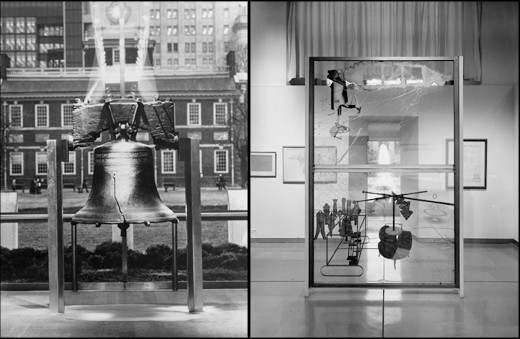
Christian Marclay, The Bell and the Glass (detail), 2003 Installation, blandteknik © Christian Marclay
The 1st at Moderna: Christian Marclay
The Bell and The Glass (sound and silence)
1.4 2006 – 2.7 2006
Stockholm
As art historian Miwon Kwon has pointed out, it was probably for the same reasons that bare, white-walled rooms – white cubes were chosen for the exhibiting of art. Silence and whiteness were considered to be neutral and free from distractions, while at the same time inducing reverence in the viewers for the objects on display, which more often than not were paintings and sculptures. Silence, as well as hushed voices in the halls of art, as in libraries, became a matter-of course – it became ‘invisible’. The absence of sound was seen as a normal condition. But is absolute silence a ‘normal’ condition? Is the absence of sound really neutral? Is silence and sound something invisible? These are questions one is compelled to ask of the art of Christian Marclay.
A well-known musician and artist, Christian Marclay works in the interface of visual art and music. However, not everyone in the music world is aware of his position in the art world, and vice versa. While attending art college at the end of the 1970s, he performed as a musician in the clubs of New York. He was interested in performance artists such as Vito Acconci and Laurie Andersson who moved freely between different art forms. A forerunner in these border areas is, of course, John Cage. But punk rock, with its indifference to musical training and virtuosity, which opened for other ways of relating to music, should also be mentioned. Marclay formed a band with the Duchampesque name The Bachelors, Even. Not a musician by training, Marclay played on turntables – and the discs were used as readymades. The rough treatment of the second-hand vinyls resulted in scratches that Marclay, in the spirit of Fluxus, accepted as music of chance and a vital part of his performances. This way of playing music and creating art was something Marclay started to work with at the end of the 1970s, that is, long before ‘sampling’ became a byword among art critics, and artists were considered DJs by relational aesthetics theoreticians.
Marclay’s imagery, the pictures and sculptures he creates, are often silent – which, of course, one could say of most art works. But in Marclay’s case the viewer is invited to reflect on this fact. Take for example The Sound of Silence (1988), a vinyl single by Simon & Garfunkel that Marclay has simply framed – a readymade. Most Western museum visitors, from different generations, are familiar with this mega hit. The mere sight of the record and its title sets off music in their heads. The record on the wall remains silent but the viewer still hears ‘The Sound of Silence.’ Or take Chorus II (1988), a series of framed, black-and-white photographs of open, apparently singing mouths, or the many sculptures in the shapes of music instruments that Marclay has created.

Liberty Bell in Liberty Bell Pavilion, 1976 © INHP
Marcel Duchamp, The Large Glass, Marcel Duchamp retrospective exhibition 1973, Philadelphia Museum of Art © Succession Marcel Duchamp/BUS 2006
With The Bell and The Glass, Marclay has created a work about the master of silence, Marcel Duchamp (both his mysterious silence on the meaning of his works and works such as With Hidden Noise make him worthy of that title) and his most famous work, The Bride Stripped Bare by Her Bachelors, Even – also called The Large Glass. The work was commissioned by the Relâche Ensemble of Philadelphia. Marclay says that he started to look for a sound that was specific for Philadelphia and which he could sample. The first thing that popped into his mind was the most famous icon of the city, The Liberty Bell. However, he soon found out that the bell was cracked, extremely fragile and impossible to use. Previously, he had always visited Philadelphia to look at the work of Duchamp, as the Philadelphia Museum of Art has the world’s most extensive Duchamp collection (followed by Moderna Museet and Musée National d’Art Moderne in Paris). He soon discovered some peculiar similarities between the two iconic objects – both the Liberty Bell and Duchamp’s glass are cracked. The result was a work in four parts: firstly, a composition by Marclay performed by the Relâche Ensemble; secondly, two superimposed video projections, reminiscent of the two-fold composition of Duchamp’s large glass; thirdly, the soundtrack of the video, which, periodically, functions as a score for the musicians that play the music of the piece, accompanied by the sound; and fourthly, a collection of artefacts relating to Duchamp’s large glass, presented with miniatures and souvenirs of the Liberty Bell. In this fashion, Marclay’s piece weaves a web of associations around the two cracked works. Like the scratches on his vinyl records, the cracks in the two cult objects are a result of chance. For a long time, Duchamp considered the glass unfinished. Finally he said that it was the crack that made the work complete. The fact that Duchamp chose glass as the material for his work may be interpreted as a way of using the transparency of the glass to include the surroundings of the work; the background became part of the work, just as the context creates meaning for his readymades. The mysterious glass becomes the subject of new interpretations, by artists and art historians – largely thanks to the silence of Duchamp.
Curator: Magnus af Petersens
The 1st at Moderna is an exhibition programme for contemporary art. The opening is always on the first day of the month, and the exhibitions are in different venues in or outside the museum.
